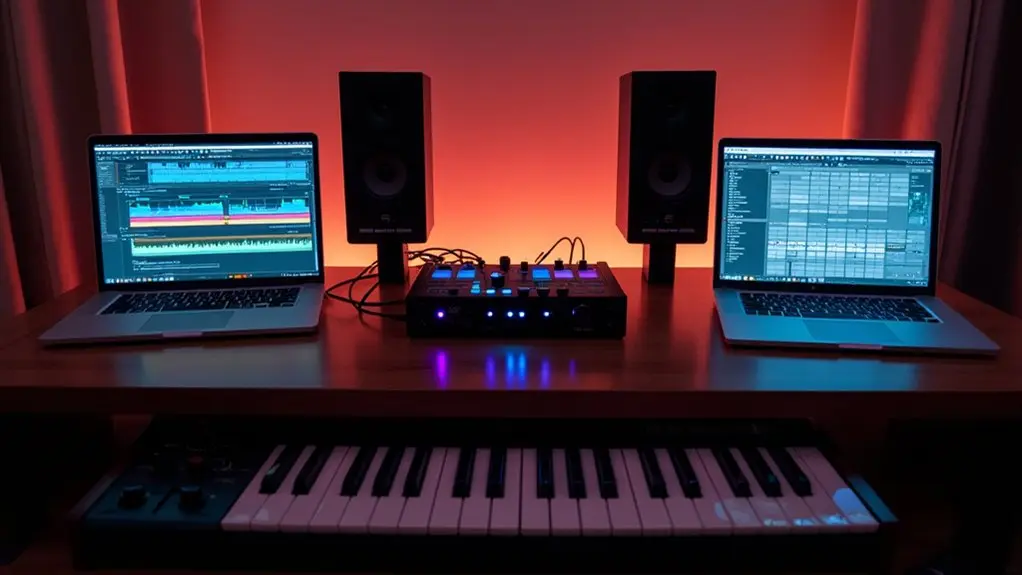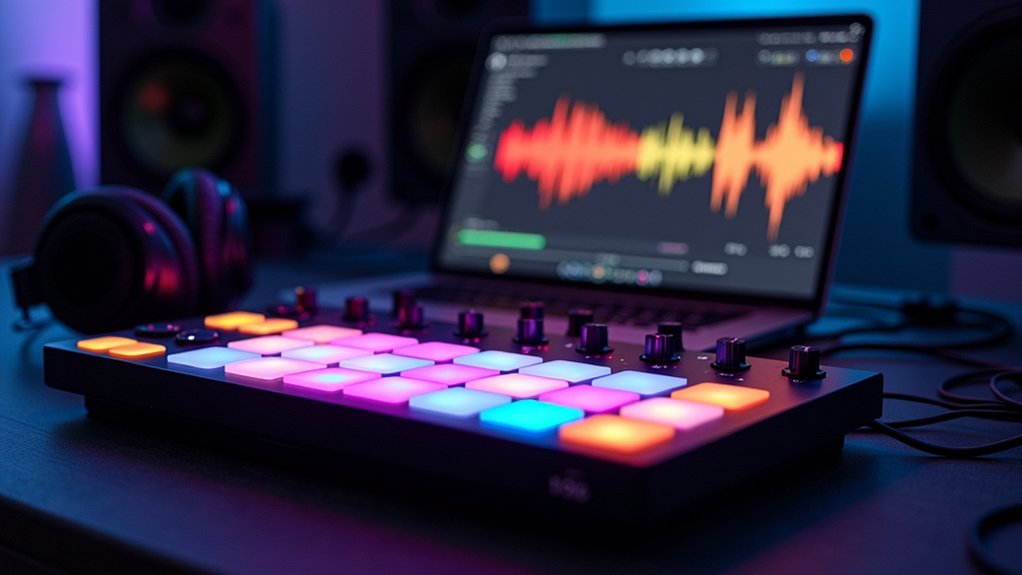Proper compression in Ableton involves methodical adjustment of threshold, ratio, attack, and release settings to achieve controlled dynamics and mix cohesion. Users should start with moderate ratios (such as 4:1), set thresholds for 0–5 dB gain reduction, and fine-tune attack/release for transient preservation or smoothing. Regular A/B testing guarantees sonic clarity and musicality, while presets offer useful starting points. Further insights reveal how to avoid common errors, sculpt different instruments, and leverage advanced compressor features.
Key Takeaways
- Set the threshold and ratio to achieve subtle gain reduction (0–5 dB) without over-compressing and losing musicality.
- Use appropriate attack and release times to preserve punch or smoothness, adjusting for the instrument’s character and mix context.
- Regularly A/B test by toggling bypass to compare compressed and uncompressed signals for desired clarity and balance.
- Start with Ableton Compressor presets for vocals or drums, then fine-tune parameters to fit your specific track dynamics.
- Monitor compression visually using the activity view to ensure consistent and controlled gain reduction throughout the track.
Understanding Audio Compression in Music Production
Audio compression serves as a fundamental tool in music production, employed to reduce the dynamic range of audio tracks by attenuating louder signals and amplifying quieter ones.
By manipulating the threshold setting, the engineer determines the precise amplitude at which compression engages; a lower threshold results in more aggressive gain reduction, impacting a greater portion of the signal.
Compression ratios commonly range between 4:1 to 8:1 for vocals, while kick drums benefit from a 4:1 ratio combined with medium to fast release times to enhance transient punch.
Attack time controls the compressor’s response speed to threshold breaches, whereas release time dictates recovery duration.
Employing A/B testing enables precise comparison between processed and unprocessed signals, allowing critical evaluation of changes in sound presence and energy introduced by audio compression.
Exploring the Ableton Compressor Interface
A thorough understanding of the Ableton Compressor interface is essential for precise dynamic control during music production.
In Ableton Live, the Compressor device offers three primary interface views: collapsed, transfer curve, and activity view. The collapsed view enables efficient parameter adjustment, while the transfer curve visualizes the compression ratio, threshold, and knee, providing insight into how input signals are affected.
The activity view displays real-time gain reduction and waveform activity, which is one of the biggest advantages for workflow transparency. Key controls include threshold (determining when compression begins), ratio (defining compression strength), attack, and release (shaping response times).
The gain reduction meter offers immediate feedback on compression intensity, facilitating meticulous dynamic management. Mastery of this interface is foundational for effective music production within Ableton Live.
Setting the Threshold: Finding the Right Starting Point
Once familiar with the layout and controls of the Ableton Compressor, precise threshold adjustment becomes the next focus for dynamic shaping.
The threshold setting dictates the specific input level at which compression engages; only signals surpassing this point will undergo gain reduction. To establish an effective starting point, gradual threshold adjustments are essential.
Begin by lowering the threshold until a moderate gain reduction—typically between 0 to 5 dB—is observed. This method provides control over the track’s dynamic range without introducing excessive compression artifacts.
The appropriate threshold is also contingent upon the source material; tracks with higher dynamic range or louder elements may require a higher threshold.
Employing A/B testing between the original and compressed signals aids in evaluating the impact on clarity and presence.
Adjusting the Ratio for Optimal Dynamics
While the threshold determines when compression begins, the ratio parameter defines the extent of gain reduction applied to signals exceeding that threshold. Compressor ratio settings directly affect dynamic range preservation and the overall energy of the mix. Lower ratios, such as 2:1 or 3:1, subtly compress the signal, maintaining musical expressiveness. Conversely, higher ratios, such as 8:1 or above, employ aggressive compression techniques, suitable for peak control on transient-heavy sources. Improperly managed, high ratios can cause excessive squashing, diminishing clarity and impact. Fine-tuning the ratio for each instrument guarantees an ideal balance between presence and natural movement. Experimentation and A/B testing reveal the best compromise between control and transparency. Utilizing FabFilter Pro-Q 3 allows precise frequency adjustments, enhancing mix clarity while maintaining the natural dynamics of the track.
| Ratio | Dynamic Range Preservation | Use Case |
|---|---|---|
| 2:1 | High | Subtle tightening |
| 4:1–8:1 | Moderate | Vocal or instrument |
| 10:1+ | Low | Aggressive compression |
Fine-Tuning Attack and Release Times
Precise adjustment of attack controls enables the preservation or attenuation of transients, directly influencing the punch and articulation of individual sounds.
Optimizing release times is essential for maintaining rhythmic integrity and preventing unwanted pumping artifacts, thereby supporting the groove of the track.
Achieving an effective balance between attack and release parameters determines how transients and sustain are managed, shaping both the clarity and energy within the mix.
Setting Attack for Punch
Many producers recognize that attack and release times are essential parameters in shaping the punch and character of compressed tracks.
Attack time insights reveal that setting a fast attack (1-10 ms) allows the compressor to clamp down quickly on transients, which is effective for transient management in percussive sounds but can reduce punch if overused.
Conversely, employing slower attack times (10-30 ms) lets more of the initial transient pass through, preserving the impact and enhancing punchiness techniques within a mix.
For vocals, a medium attack time (5-15 ms) balances clarity and presence without over-compressing dynamic nuances.
Careful A/B testing of attack settings guarantees the desired punch is achieved without sacrificing natural instrument character, making attack time a vital element in dynamic control.
Optimizing Release for Groove
A critical component in shaping a track’s rhythmic feel, release time in compression governs how rapidly gain reduction ceases once the input signal subsides below the threshold. Effective release time strategies are vital for optimizing dynamic response and maintaining the intended groove.
Fast release times are typically employed as groove enhancement techniques for percussive elements, allowing transients to recover swiftly and preserving rhythmic punch. Conversely, slower release times can be advantageous for sustaining instruments, providing smoother volume shifts that contribute to sonic cohesion.
Fine-tuning both attack and release parameters guarantees that compression supports, rather than disrupts, the musical flow. Systematic experimentation with release time settings enables producers to tailor the compressor’s behavior, achieving dynamic response optimization that enhances groove and overall track energy without unnecessary artifacts.
Balancing Transients and Sustain
Transients and sustain represent two critical dimensions of a sound’s envelope, each shaped by the compressor’s attack and release parameters.
Effective transient shaping techniques begin with adjusting the attack time: a fast attack (1-10 ms) clamps down aggressively on transients, increasing punch and tightness—ideal for percussive instruments.
Conversely, a slower attack (10-50 ms) allows initial transients to cut through, preserving natural articulation and clarity.
Sustain control methods rely on manipulating the release time; setting it within a medium range (50-100 ms) guarantees the compressor recovers in step with the track’s groove, balancing dynamic range while avoiding unnatural pumping.
Dynamic range balancing is achieved by A/B testing various attack and release settings, enabling precise calibration for best transient retention and controlled sustain within the mix.
Utilizing the Transfer Curve and Activity Views
Visualization plays a critical role in mastering compression within Ableton, particularly through the transfer curve and activity views. The transfer curve visualization offers a real-time graphical representation of how input signal levels are mapped to output levels, enabling precise threshold and ratio adjustments. This direct feedback assists users in maintaining audio signal integrity while achieving ideal compression.
Activity view analysis complements this by displaying the audio waveform alongside the compressor’s gain reduction, making it possible to monitor how transients are processed and how quickly the compressor responds to peaks. This is especially important for percussive elements where a punchy sound is desired.
Utilizing both views concurrently allows for a thorough compression impact assessment, ensuring adjustments are both technically informed and musically effective within the mix.
A/B Testing: Hearing the Impact of Compression
How does one determine the true impact of compression on a track? A/B testing techniques offer a systematic approach to compression impact analysis by enabling direct comparison between the unprocessed and processed signal.
By soloing the track and toggling the compressor on and off, engineers can identify subtle sound differences in presence, energy, and tonal balance. It is advisable to set the gain reduction within the 0 to 5 dB range, ensuring the changes remain nuanced rather than overwhelming.
Critical listening during these comparisons reveals whether the compression enhances clarity and balance without sacrificing dynamic range. Initial adjustments should occur in isolation, allowing for precise evaluation before integrating the track back into the full mix for further assessment of its sonic character and interaction.
Compressing Vocals for Consistency and Clarity
When compressing vocals in Ableton, engineers typically employ a ratio between 4:1 and 8:1 to effectively manage dynamic range while preserving intelligibility.
Precise adjustment of threshold, attack, and release parameters is critical for maintaining vocal presence and clarity, with fast attack times controlling transients and slower releases ensuring smooth volume recovery.
Monitoring these settings in the context of the full mix enables ideal balance between dynamic control and the natural expressiveness of the performance.
Setting Optimal Compressor Parameters
Effectively compressing vocals requires precise adjustment of compressor parameters to achieve both consistency and clarity within a mix.
A common compression myth is that higher ratios always result in better vocal clarity; however, a ratio between 4:1 and 8:1 is typically ideal for controlling dynamic range while preserving presence.
Setting the threshold to yield 0–5 dB of gain reduction guarantees the compressor maintains clarity without over-squashing the signal.
Employing a fast attack time captures transient peaks, contributing to a consistent vocal performance and preventing harsh peaks from piercing the mix.
Conversely, a slower release time allows the vocal level to recover naturally, avoiding an overly aggressive or pumping effect.
Regular A/B testing is critical to discern subtle shifts in clarity and energy, verifying effective parameter selection.
Balancing Presence and Dynamics
While achieving vocal consistency is essential in modern music production, balancing presence and dynamics through compression requires careful parameter selection and critical listening.
Effective dynamic range management is achieved by applying vocal clarity techniques within precise compressor settings. A methodical approach includes:
- Set Compression Ratio: Use a ratio between 4:1 and 8:1 to maintain clarity while controlling peaks.
- Adjust Threshold: Target the threshold to capture louder transients, aiming for 0–5 dB gain reduction for polish without over-compression.
- Tweak Attack/Release: Employ a fast attack to manage transients and a slower release for natural vocal flow.
- A/B Testing: Regularly compare compressed and uncompressed signals to guarantee presence and avoid artifacts.
Compression myths debunked: excessive compression does not enhance clarity; nuanced adjustments yield transparent, consistent vocals.
Shaping Kick Drums for Punch and Presence
Shaping kick drums for punch and presence involves precise adjustment of compressor parameters to control dynamics without sacrificing transient impact.
Effective kick drum layering benefits from a compressor set to a 4:1 ratio, offering dynamic control without dulling the attack. Implementing a medium to fast attack time is critical for transient shaping, as it allows the initial transient to pass through, resulting in a punchy low end that cuts through the mix.
Release time should be quick enough for the compressor to reset before subsequent hits, maintaining rhythmic integrity and energy. Targeting 3 to 5 dB of gain reduction tightens the sound while preserving natural dynamics.
A/B testing is recommended to evaluate the improvement in clarity and presence achieved through careful adjustment of these parameters.
Balancing Instruments With Compression in the Mix
A fundamental aspect of achieving a cohesive mix involves applying compression to individual instruments, ensuring controlled dynamic range and enhanced clarity across the frequency spectrum.
Effective mixing techniques leverage dynamic control to balance each element, making certain that no instrument dominates or is buried within the mix. Analytical adjustments to compression parameters are required for ideal instrument interaction.
Consider the following technical steps:
- Set the threshold and ratio for each instrument, tailoring settings such as 4:1 to 8:1 ratios for vocals to maintain intelligibility.
- Apply faster attack times on percussive elements to preserve punch and allow transient detail.
- Use A/B testing to evaluate the sonic impact, ensuring subtlety and transparency.
- Continuously monitor instrument interaction within the full mix to maintain balance and clarity across the arrangement.
Avoiding Common Compression Mistakes
Why do so many mixes suffer from lifelessness or unnatural dynamics despite the use of compression? A primary reason lies in common pitfalls and compression myths that persist among producers.
One frequent mistake is setting the threshold too high, resulting in negligible gain reduction and leaving the dynamic range unaffected. Conversely, excessive compression ratios can diminish dynamic range, rendering tracks flat and uninspired.
Misjudged attack and release times, especially when not tailored to the source material, often create unnatural transients or pump artifacts. Additionally, neglecting to perform A/B testing obscures the true effect of compression, while failing to evaluate the broader mix context risks unbalanced results.
Understanding these issues is vital to maintaining musicality and avoiding the trap of over-processing that plagues many mixes.
Leveraging Presets and Further Learning Resources
Ableton Live’s compressor presets provide instrument-specific starting points, which users can analyze to understand parameter interactions and sonic outcomes. By modifying these preset configurations, producers can optimize compression to suit the dynamic requirements of individual tracks. For thorough technical instruction and practical demonstrations, platforms such as sequence one.org offer targeted tutorials that enhance both theoretical understanding and hands-on proficiency. Additionally, exploring Mastering Ableton Live for beginners can provide valuable insights into the use of fundamental tools and mixing techniques essential for any music project.
Exploring Preset Options
While maneuvering the dynamic range control within Ableton’s compressor, users encounter an array of carefully crafted presets tailored for diverse instrument and vocal applications.
Preset experimentation provides immediate access to industry-standard compression scenarios, expediting workflow and offering foundational guidance for those less familiar with threshold and ratio settings.
However, understanding preset limitations is essential; these configurations serve as generic starting points and may not account for unique sonic characteristics in every track.
A/B testing facilitates critical listening, enabling users to assess how different preset applications alter the audio signal.
For structured exploration, consider the following:
- Select instrument- or vocal-specific presets for targeted compression.
- Observe parameter shifts to learn standard practices.
- Apply A/B testing to evaluate effectiveness.
- Reference external learning resources for deeper technical insight.
Customizing Preset Settings
Building on the foundational understanding gained from preset exploration, customization of these settings allows users to tailor compression parameters to the specific dynamics of their tracks.
Effective preset selection strategies involve choosing a factory preset closely matching the instrument or vocal character, then fine-tuning its threshold, ratio, attack, and release to optimize dynamic control.
Adjusting compression techniques—such as modifying attack for transient shaping or release for sustain—enables precise management of signal peaks and sustain phases.
Utilizing Ableton’s activity view offers visual feedback on gain reduction, supporting the iterative process of tailoring sound profiles.
A/B testing between the processed and original track confirms whether the desired enhancements in clarity and energy have been achieved, ensuring that custom settings are contextually appropriate for the overall mix.
Recommended Learning Platforms
A strategic approach to mastering compression in music production involves utilizing both built-in presets and a robust selection of educational platforms.
Presets in Ableton’s compressor provide an efficient entry point for quickly achieving foundational dynamics, while further expertise is developed through targeted learning resources.
To refine technical skills and analytical listening, consider the following platforms:
- Online courses—Structured curriculums offer in-depth modules on compression, signal flow, and critical listening.
- Video tutorials—Platforms such as sequenceone.org provide step-by-step guidance on applying and tweaking compressor settings.
- Interactive workshops—Live sessions allow for real-time Q&A and hands-on demonstrations with industry professionals.
- A/B testing exercises—Many resources include practical assignments to compare presets and manual adjustments, reinforcing theoretical knowledge with applied practice.
Frequently Asked Questions
How to Compress a Track in Ableton?
To compress a track in Ableton, one applies compression techniques by inserting the Compressor effect, adjusting threshold, ratio, attack, and release parameters, thereby controlling dynamic range and enhancing audio mixing clarity through precise gain reduction and real-time A/B comparison.
Should I Compress All My Tracks?
The decision to compress all tracks depends on individual track dynamics and the desired mixing techniques. Selective compression preserves audio clarity, prevents over-processing, and enhances overall mix balance, making critical evaluation essential rather than applying compression universally.
How Good Is Ableton’s Compressor?
The current question evaluates Ableton features by analyzing compressor settings and their impact on audio dynamics. Ableton’s compressor offers precise control, real-time visual feedback, and versatile applications, making it a robust tool for managing dynamic range in professional productions.
What Does Compressing a Track Do?
Compressing a track reduces its dynamic range, allowing softer and louder audio signals to become more balanced. This technique enhances audio clarity and cohesion within a mix, making it an essential component of professional mixing techniques and sound engineering.
Conclusion
In conclusion, mastering the Ableton Compressor involves a systematic approach—understanding threshold, ratio, attack, and release parameters is essential for precise dynamic control. Proper application guarantees punchy kick drums, balanced instrument levels, and overall mix cohesion. By avoiding over-compression and utilizing presets as learning tools, producers can achieve transparent, musical results. Continued exploration of compressor functions within Ableton Live empowers users to make informed, technical decisions that enhance both clarity and impact in modern music production workflows.




